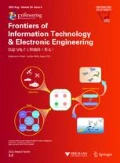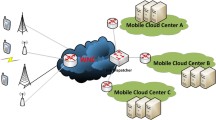Abstract
Mobile cloud computing (MCC) has become a promising technique to deal with computation- or data-intensive tasks. It overcomes the limited processing power, poor storage capacity, and short battery life of mobile devices. Providing continuous and on-demand services, MCC argues that the service must be available for users at anytime and anywhere. However, at present, the service availability of MCC is usually measured by some certain metrics of a real-world system, and the results do not have broad representation since different systems have different load levels, different deployments, and many other random factors. Meanwhile, for large-scale and complex types of services in MCC systems, simulation-based methods (such as Monte-Carlo simulation) may be costly and the traditional state-based methods always suffer from the problem of state-space explosion. In this paper, to overcome these shortcomings, fluid-flow approximation, a breakthrough to avoid state-space explosion, is adopted to analyze the service availability of MCC. Four critical metrics, including response time of service, minimum sensing time of devices, minimum number of nodes chosen, and action throughput, are defined to estimate the availability by solving a group of ordinary differential equations even before the MCC system is fully deployed. Experimental results show that our method costs less time in analyzing the service availability of MCC than the Markov- or simulation-based methods.
Similar content being viewed by others
References
Bradley, J.T., Gilmore, S.T., Hillston, J., 2008. Analysing distributed Internet worm attacks using continuous statespace approximation of process algebra models. J. Comput. Syst. Sci., 74(6):1013–1032. [doi:10.1016/j.jcss.2007.07.005]
Castiglione, A., Gribaudo, M., Iacono, M., et al., 2014. Exploiting mean field analysis to model performances of big data architectures. Fut. Gener. Comput. Syst., 37:203–211. [doi:10.1016/j.future.2013.07.016]
Chilwan, A., Undheim, A., Heegaard, P.E., 2011. Effects of dynamic cloud cluster load on differentiated service availability. 21st Int. Conf. on Computer Communications and Networks, p.1–6. [doi:10.1109/ICCCN.2012.6289310]
Dinh, H.T., Lee, C., Niyato, D., et al., 2013. A survey of mobile cloud computing: architecture, applications, and approaches. Wirel. Commun. Mob. Comput., 13(18):1587–1611. [doi:10.1002/wcm.1203]
Ever, E., Gemikonakli, O., Kocyigit, A., et al., 2013. A hybrid approach to minimize state space explosion problem for the solution of two stage tandem queues. J. Netw. Comput. Appl., 36(2):908–926. [doi:10.1016/j.jnca.2012.10.006]
Fernando, N., Loke, S.W., Rahayu, W., 2013. Mobile cloud computing: a survey. Fut. Gener. Comput. Syst., 29(1): 84–106. [doi:10.1016/j.future.2012.05.023]
Fourneau, J.M., Kloul, L., Valois, F., 2002. Performance modelling of hierarchical cellular networks using PEPA. Perform. Eval., 50(2–3):83–99. [doi:10.1016/S0166-5316(02)00101-3]
Gens, F., Adam, M., Bradshaw, D., et al., 2013. Worldwide and Regional Public IT Cloud Services 2013–2017 Forecast. IDC Market Analysis #242464.
Hayden, R.A., Bradley, J.T., 2008. Fluid semantics for passive stochastic process algebra cooperation. Proc. 3rd Int. ICST Conf. on Performance Evaluation Methodologies and Tools, p.1–10. [doi:10.4108/ICST.VALUETOOLS 2008.4329]
Hayden, R.A., Stefanek, A., Bradley, J.T., 2012. Fluid computation of passage-time distributions in large Markov models. Theor. Comput. Sci., 413(1):106–141. [doi:10.1016/j.tcs.2011.07.017]
Hillston, J., 2005. Fluid flow approximation of PEPA models. Proc. 2nd Int. Conf. on Quantitative Evaluation of Systems, p.33–42. [doi:10.1109/QEST.2005.12]
Huang, Y., Kintala, C., Kolettis, N., et al., 1995. Software rejuvenation: analysis, module and applications. 25th Int. Symp. on Fault-Tolerant Computing, p.81–390. [doi:10.1109/FTCS.1995.466961]
Huerta-Canepa, G., Lee, D., 2010. A virtual cloud computing provider for mobile devices. Proc. 1st ACM Workshop on Mobile Cloud Computing & Services: Social Networks and Beyond, Article 6, p.1–5. [doi:10.1145/1810931.1810937]
Longo, F., Ghosh, R., Naik, K., et al., 2011. A scalable availability model for Infrastructure-as-a-Service cloud. IEEE/IFIP 41st Int. Conf. on Dependable Systems & Networks, p.335–346. [doi:10.1109/DSN.2011.5958247]
Ou, S., Yang, K., Zhang, J., 2007. An effective offloading middleware for pervasive services on mobile devices. Perv. Mob. Comput., 3(4):362–385. [doi:10.1016/j.pmcj.2007.04.004]
Qi, H., Gani, A., 2012. Research on mobile cloud computing: Review, trend and perspectives. 2nd Int. Conf. on Digital Information and Communication Technology and Its Applications, p.195–202. [doi:10.1109/DICTAP.2012.6215350]
Rishabh, S., Sanjay, K., Munesh, C.T., 2013. Mobile cloud computing: a needed shift from cloud to mobile cloud. 5th Int. Conf. on Computational Intelligence and Communication Networks, p.536–539. [doi:10.1109/CICN.2013.116]
Satyanarayanan, M., 2011. Mobile computing: the next decade. ACM SIGMOBILE Mob. Comput. Commun. Rev., 15(2):2–10. [doi:10.1145/2016598.2016600]
Singh, G., Kumar, R., 2012. Availability metrics for cloud vibrant behaviour with benchmarks influence on diverse facets. Int. J. Softw. Eng. Appl., 3(1):101–115. [doi:10.5121/ijsea.2012.3108]
Tribastone, M., 2007. The Pepa Plug-in Project. 4th Int. Conf. on the Quantitative Evaluation of Systems, p.53–54. [doi:10.1109/QEST.2007.34]
Tribastone, M., Gilmore, S., Hillston, J., 2012a. Scalable differential analysis of process algebra models. IEEE Trans. Softw. Eng., 38(1):205–219. [doi:10.1109/TSE.2010.82]
Tribastone, M., Ding, J., Gilmore, S., et al., 2012b. Fluid rewards for a stochastic process algebra. IEEE Trans. Softw. Eng., 38(4):861–874. [doi:10.1109/TSE.2011.81]
Undheim, A., Chilwan, A., Heegaard, P., et al., 2011. Differentiated availability in cloud computing SLAs. 12th IEEE/ACM Int. Conf. on Grid Computing, p.129–136. [doi:10.1109/Grid.2011.25]
Widjajarto, A., Supangkat, S.H., Gondokaryono, Y.S., et al., 2012. Cloud computing reference model: the modelling of service availability based on application profile and resource allocation. Int. Conf. on Cloud Computing and Social Networking, p.1–4.
Wu, L., Garg, S.K., Buyya, R., 2012. SLA-based admission control for a Software-as-a-Service provider in cloud computing environments. J. Comput. Syst. Sci., 78(5): 1280–1299. [doi:10.1016/j.jcss.2011.12.014]
Author information
Authors and Affiliations
Corresponding author
Additional information
Project supported by the National Natural Science Foundation of China (Nos. 61402127 and 61370212) and the Natural Science Foundation of Heilongjiang Province, China (No. F2015029)
ORCID: Hong-wu LV, http://orcid.org/0000-0002-1917-3978
Rights and permissions
About this article
Cite this article
Lv, Hw., Lin, Jy., Wang, Hq. et al. Analyzing the service availability of mobile cloud computing systems by fluid-flow approximation. Frontiers Inf Technol Electronic Eng 16, 553–567 (2015). https://doi.org/10.1631/FITEE.1400410
Received:
Accepted:
Published:
Issue Date:
DOI: https://doi.org/10.1631/FITEE.1400410




